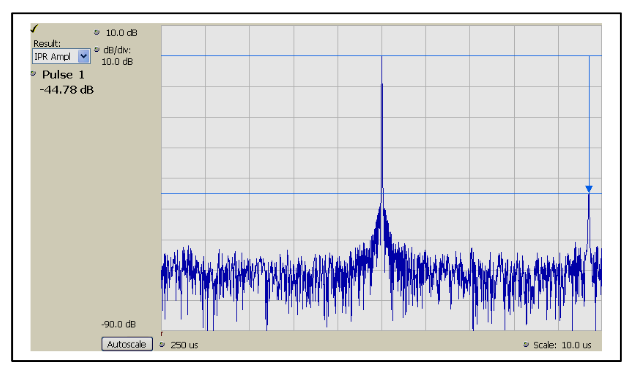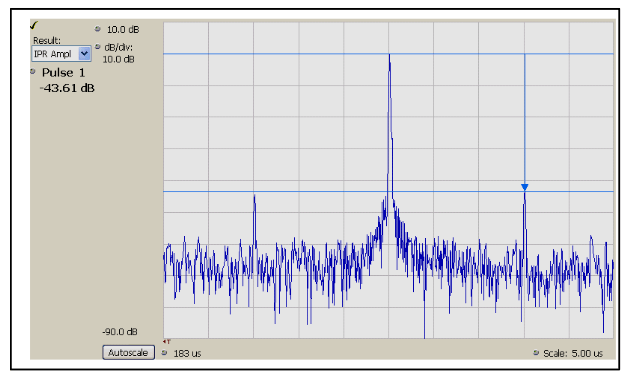Abstract - An enhanced impulse response measurement for a linear frequency modulation (FM) radar transmitter signal provides a more accurate measurement of the amplitude of a secondary response relative to the main response. Measurement of the secondary pulse is degraded by loss of the portion of the secondary pulse that is outside the time of the main pulse. The measurement is corrected to eliminate the amplitude error of the secondary response caused by the combination of the time offset of the secondary response combined with the application of the time windowing function. This measurement can be performed using a signal analyzer on the RF output of the radar using the radar's own chirp as the internal excitation.
I. Introduction
One measurement of the quality of a linear FM chirp is Impulse Response. The linearity of frequency or phase of the chirp tells part of the story. If a reflection or other time-related mechanism results in a delayed copy of the intended pulse (a secondary pulse) added to the main pulse, a linearity measurements may not easily discover the problem.
Such a secondary pulse can be simultaneously measured for both time delay and relative amplitude by plotting the impulse response of the main chirp pulse. This is functionally equivalent to a TDR using the chirp itself as the excitation signal.
The method described here adds an amplitude correction to such an impulse response measurement so that the amplitude of the secondary pulse relative to the main pulse will be correctly reported throughout the measurable range of delay time.
Fig. 1 is one example of a possible cause of such a secondary pulse. In this case the delay time of the secondary is twice the delay time of the transmission path between the reflections.
The RF waveform of the combined main and secondary pulses is shown in Fig. 2. The larger trace is the original chirp and the smaller delayed trace is the secondary copy which is delayed. In this case the delay time is equal to almost half of the pulse duration time.
Since the measurement window is concurrent with the duration time of the main pulse, the delay time measurement is limited to one half of the pulse duration of the chirp.


II. THE IMPULSE RESPONSE MEASUREMENT
A. The basic Impulse Response (IPR).
The incoming RF pulse is digitized and the resultant record of sequential time samples is mathematically processed to provide the IPR measurement.

B. The Time-Window.
As shown in Fig. 3, after the incoming signal is digitized, a time window is applied to the samples to reduce undesired sidelobes that would be generated by the Discrete Fourier Transform for a signal that is not continuous. For this purpose a Taylor window provides a good compromise of main lobe width and reduced sidelobe generation.
Equation (1) describes a Taylor window function [2]. Fig. 4 is a plot of this time window.

For values of n = 0 to N-1

The windowed set of time samples is then transformed into a frequency-domain spectrum. This can be accomplished by any of several Discrete Time Transform processes, including the Fast Fourier Transform (FFT).
This spectrum data is then multiplied by the complex conjugate of a representation of an ideal chirp as was expected to have been transmitted.
In a practical implementation of a measurement tool, this ideal chirp can be mathematically estimated using the actual incoming signal, or it can be entered by the equipment operator for increased measurement accuracy.
The multiplication de-chirps the acquired pulse. After de-chirping, the Inverse Frequency Transform is performed to transform the result back into the time domain. This is now the traditional Impulse Response of the incoming chirp signal which passed through the radar system [1].
C. The Resulting Amplitude Reduction of the Secondary.
Since the Impulse Response measurement is calculated only over the duration of the main chirp pulse, the reflection pulse will be truncated by an amount equal to the delay time of the reflection from the main pulse. According to Parseval's theorem the total frequency-domain power (voltage squared) is equal to the total time-domain power (voltage squared).
The missing portion of the secondary pulse is seen in Fig. 2 as the small amplitude signal to the right of the main signal.
Additionally the time window function adds more loss as the time delay becomes larger.

In the upper part of Fig. 5 the main pulse has the time window applied. The time over which the window is applied is determined by the pulse duration of the main pulse. Therefore, in the lower part the delayed secondary pulse is shown with the same time window applied. This example shows a secondary pulse that has been delayed by a time equal to 30% of the main pulse duration.
This reduction in the processed amplitude of the secondary pulse will cause an error in the reported measurement result for its amplitude if no correction is applied.
This error is only present for the amplitude and has no effect on the measurement of the time delay. The amplitude effect is largest when the delay of the secondary pulse is large, and has negligible effect when the delay time is small compared to the pulse duration.
III. THE AMPLITUDE CORRECTION METHOD
A. The Basic Solution.
The amplitude error can be corrected by adding one more processing block after the IPR is initially calculated.The new addition to the IPR calculation process is the amplitude correction block seen at the far right of Fig. 6.

B. The correction Method.
The method described here treats the effects on the main and secondary pulses separately. For each, the energy is found by integrating the power over the measurement time. In this manner the window function can be applied during the integration.
First the time-window for the FFT is defined as existing only for the time-duration of the main pulse. The window, W(t) is evaluated for values of t when:

where T is the main pulse width.
The energy of the main windowed pulse can now be expressed as:

Where A is the pulse amplitude.
For a delay of td,the energy of the reflected windowed pulse is:

The energy of each signal in discrete time form can also be calculated by replacing the integration with summation.
C. Calculating the set of Correction Values to be Applied.

First the attenuation factor is calculated as the energy of the secondary pulse divided by the energy of the main pulse using (6). This is how much smaller the secondary pulse is than it would have been if it were not reduced by the signal processing.

The correction that needs to be applied to the IPR plot is the inverse of the attenuation of the secondary pulse.This correction can be expressed in dB as in (7).

The correction curve of Fig. 7 is calculated individually for each measurement and applied in the far right block in Fig. 6.As the measurement limit of 50% of the pulse duration is approached, the correction factor can approach 3 dB for the window chosen here.
D. IPR Results with and without the correction.
Fig. 8 shows a measurement result of the secondary pulse (time side-lobe) 44.78 dB below the main pulse (main lobe).
In Fig. 9 the correction has been applied and the measurement result now shows the secondary as 42.40 dB below the main pulse. This is a correction of 2.38 dB.



E. IPR Measurements for other pulse defects.
Measurements which include a secondary reflected pulse are one use of this measure of quality. There are other pulse conditions that also can be measured using this method. One example is a chirp pulse that has incidental sinusoidal modulation.
The relationship between the impulse sidelobe delay time and the frequency components of the chirp is given in (8).

Where is the time difference between the time sidelobes and the main lobe, Fm is the frequency of the incidental modulation, Td is the duration time of the chirp, and Fd is the frequency sweep width during the chirp.
Such a pulse exhibits modulation sidebands on both sides of the carrier in the frequency domain. For a chirp pulse, this effectively has a secondary pulse both preceding and following the main pulse in the time domain.
The example displayed in Fig. 10 has a chirp width of 100 MHz, time duration of 10 microseconds, and incidental AM modulation at 15 MHz rate. This results in time sidelobes at 1.5 microseconds on both sides of the main lobe.
IV. CONCLUSION
An improved method of measuring the time impulse response of chirp radar pulses when using a signal analyzer has been presented. This algorithm provides improved amplitude measurement accuracy for chirp pulses containing a reflection, particularly when the secondary response has delay approaching 50% of the main pulse length.
ACKNOWLEDGMENT
The authors wish to acknowledge the assistance provided by Michael Nelson, Darren McCarthy and Marcus DaSilva in the preparation of this paper.

